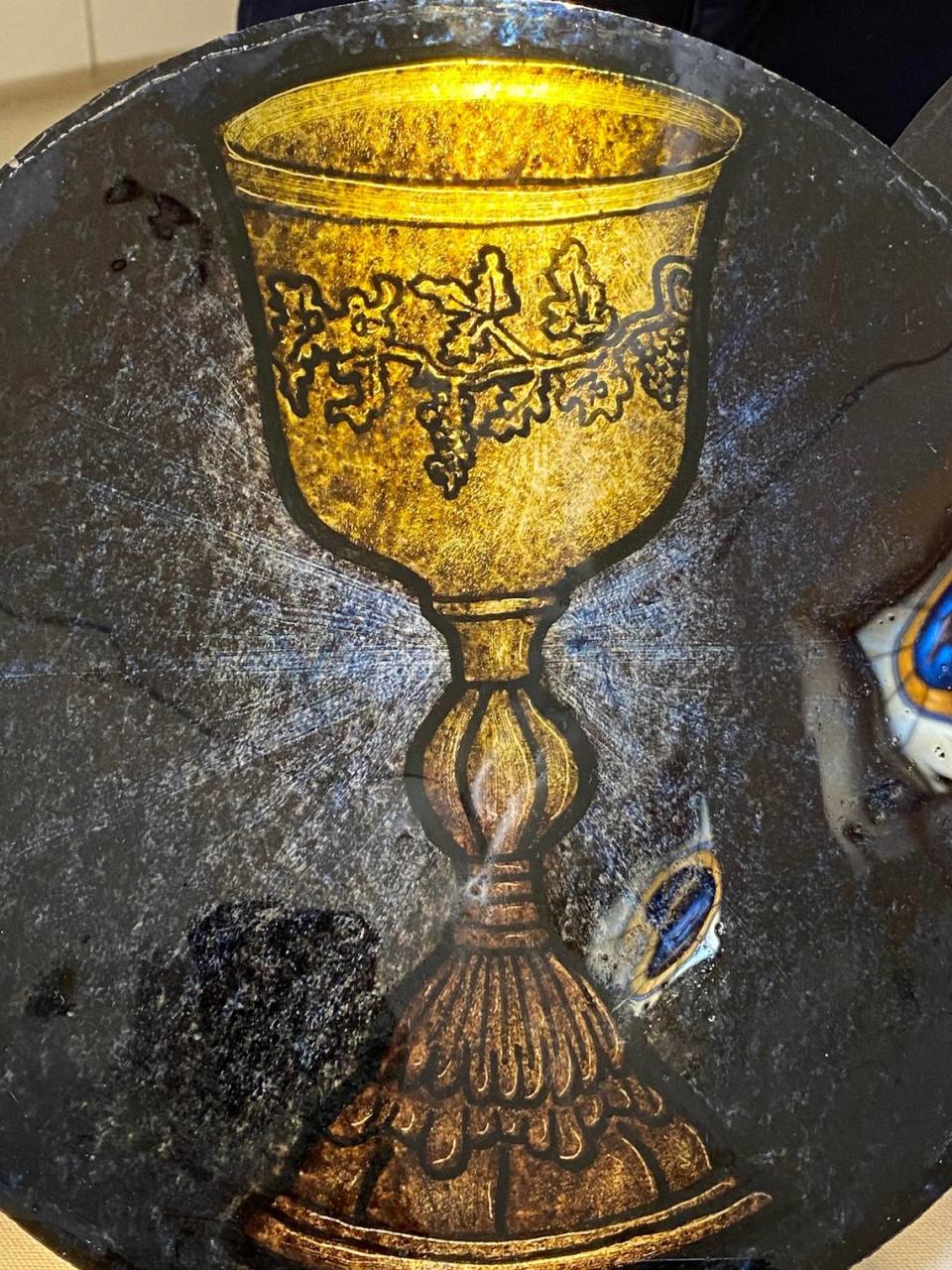These stained glass windows on display at Beth-El Congregation are a window to the past.
An inspiring exhibit of antique stained glass, on display this year at Beth-El Congregation, demonstrates that objects of art deemed passé in one era may grow in value through the prism of time.
Twenty-three years ago, when Beth-El voted to sell its 1920s-era building on the Near Southside and construct a contemporary synagogue seven miles away in Southwest Fort Worth, a metaphorical tug-of-war ensued over whether to salvage 36 of the building’s circular stained-glass window panes.
The original stained glass, with its somber, muted colors and realistic images, was long out of style. The interior decorators’ preference was for bright, contemporary windows with abstract motifs. The old medallions would look dated in the new building’s soaring, 21st-century limestone sanctuary.
Architect David Stanford’s design allowed for a dozen of the antique medallions to fill windows in the new temple’s Hall of Remembrance, a mini-museum that pays homage to Beth-El’s history. But there was no place for the remaining stained-glass panes. At a time when every fundraising dollar was needed for the $11 million synagogue under construction, the antique stained glass would be too expensive to salvage unless adaptively reused.
Remarkably, many other elements of the old building made the move: A frieze inscribed with a quote from Psalms was stripped from the front façade and transplanted onto a garden wall. A pair of 8-foot limestone menorahs embedded in brick were removed piece by piece and reassembled for the new synagogue’s entrance. A 1940s Art Deco gate with a Star of David radiating from its center moved to the next location, as did two granite cornerstones and 17 ornamental light fixtures.
However, the stained-glass medallions remained a point of contention. Doggedly, preservationists lobbied to salvage the panes, even if it meant storing them out of sight in the temple archives for years. The fragile stained-glass discs measured 12- to 18-inches in diameter and wouldn’t take up much space.

Diehard preservationists researching the history of the windows then found a compelling reason to cling to them. A document in the archives and illustrations in an art book published in 1946 showed that the hand-painted, kiln-fired images in each stained-glass disc depicted Jewish ceremonial objects from communities destroyed in the Holocaust. The window panes linked Fort Worth Jewry to generations that had perished.
With $7,000 in private donations, those window panes were ultimately removed and stored in plywood crates built by two members in the Beth-El Brotherhood.
The meaningful stories the stained glass art convey are explained in an exhibit titled “Stained Glass: Through the Prism of Time.”
Captions in the exhibit state that the Hanukkah menorah pictured on one pane was designed in Frankfurt around 1700 when Jewish artisans thrived. The Passover plate on another medallion was signed by a German silversmith in 1779. A wine goblet, with grapevines etched onto its surface, dates to 18th century Breslau. A triple-branched Sabbath candelabra was typical of Judaica from Krakow, a Polish city where 65,000 Jews perished.
Star Trek fans would recognize another image — two hands raised in a priestly blessing resembling the Vulcan salute. The image has Judaic origins and was copied from a detail on a Russian prayer wall. The fingers are separated in a manner that simulates the Hebrew letter “shin,” a reference to God meaning “the almighty.” Actor Leonard Nimoy, who grew up in an Orthodox Jewish home, suggested the gesture for Star Trek’s “live-long-and-prosper” greeting.

Also startling to contemporary viewers is a stained-glass pane filled with a yellow Jewish star. To the Nazis, the yellow, six-pointed star was a badge of shame that Jews were forced to sew onto their garments. The designer who planned Beth-El’s windows in 1946 was Erno Fabry, a Hungarian refugee who lost his family in the Holocaust. His intention was to reclaim the icon from the Nazis and imbue the yellow star with pride, defiance, strength, and beauty.
In March of 2020, a week before the Covid pandemic curtailed activities at Beth-El, the Temple Archives Committee brought the antique panes out of storage with plans to exhibit them in a new light. During the lockdown, volunteers emailed back and forth to write captions, discuss lighting, compose inspirational lines and compile an album of color photos and a narrative about the windows’ history.

This past September, as worshipers wearing face masks returned to indoor services, the antique panes went on display in a showcase near the synagogue’s front door and in the Hall of Remembrance. Examining the images in a new light and a new setting, many congregants asked if the medallions were on loan from a museum. Emphatically, no! This was the same stained glass that had inspired worshipers for generations.
“Stained-glass panels are often ... so much more than just raw material that can be disposed of in cavalier fashion,” observed Alanna Cooper, a cultural anthropologist at Ohio’s Western Reserve University, who researches the “afterlives” of sacred objects. “These are not just works of art ... They are vibrant materials, engaging with the natural light, and shaping congregants’ experiences of the sacred.”
About the exhibit
Stained Glass: Through the Prism of Time, current exhibit at Beth-El Congregation, 4900 Briarhaven Road.
Hours, Monday through Friday, 9 a.m. to 4:30 p.m.
To arrange self-guided or docent-led tours, phone 817-332-7141.
Face masks and vaccination card required.
Directions: www.bethelfw.org
Synagogue open to the public for Sabbath services Fridays, 6:15- 7:15 pm.
Columnist Hollace Ava Weiner, an author, historian, and archivist, curated the exhibit.

 Yahoo Movies
Yahoo Movies 
